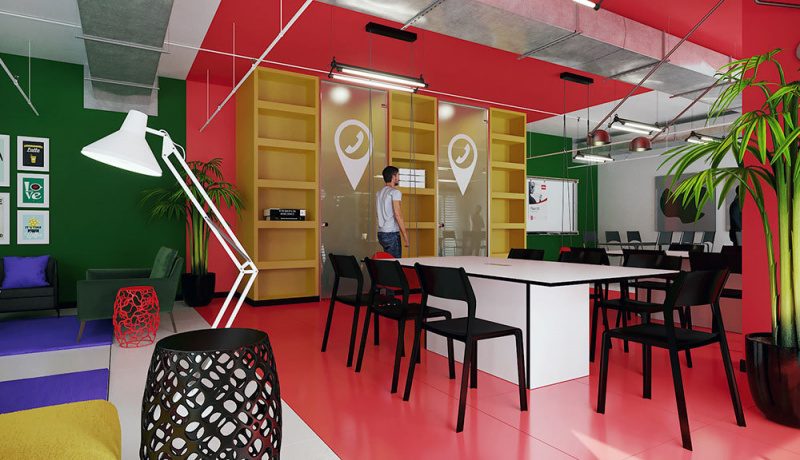The global coliving market grows at 30% a year
Living together gets rid of loneliness and can boost careers
In October 2021, Becar will open the emirate's first YouCo coliving in Dubai. Renting a unit there will cost 4,600 UAE dirhams per month ($1,252.31). Renting a similar apartment now costs 5,500 UAE dirhams a month ($1,497.33). / Becar Asset Management.
Unsurprisingly, the foreign colivings market is outpaced the Russian market in many ways: it emerged much earlier. Some sources stretched back to 1933-1934, when Wells Coats in London designed a shared living space called "IsoCon" with a common work area and laundry. Others call the first modern coliving a mansion in Cupertino, California, USA, which was rented in 2006 by five fellow commuters who came to work at the Ames Research Center. Since then, other houses for like-minded people have sprung up. As a rule, they live by 15-20 people, and to get there is extremely difficult - almost every place has a competition.
Reza Merchant, who opened the Old Oak in London for several hundred units in 2016, rethought the idea of colivings. He wanted to create not just a house for life of interest, but a place where yesterday's students would be as comfortable as on university campuses.
By the end of 2020, there were about 180 colving operators worldwide with a total number of about 4,000 facilities and more than 250,000 rental units. According to Becar, the percentage of network colivings in the world (from two projects in the network) is 97.3%, about 900 new ones opened in 2020, growth for the year - 30%.
Monk Realty Solutions Pvt Ltd. estimates the global colivings market size in 2020 at $7.952 billion, up 6% from 2019, and the total number of colivings and serviced apartment guests worldwide in 2020 - at 3.351 million people (+13% per year).
89% of all colivings are concentrated in Asia
99% of them are in three countries - China, India, and Singapore. It is difficult to accurately estimate the scale in China - most of the venues are designed for the domestic market. North America's percentage is just over 5% (of which 97% is in the U.S.), and 6% in Europe. In Europe, the most colivings (by number of locations) is in Great Britain (27%), the Netherlands (19%), France (12%), Germany and Belgium (8% each). In South America, there are colivings in Brazil and Argentina, and in Africa, in South Africa and Morocco. Coliwings are open in Australia.
There is still no generally accepted standard for such housing: both small private communes and large facilities with several hundred rooms are called colivings. The most common format, according to Becar, is an apartment or a small private home, which at the end of September 2020 were 69% of the colving in the world, and 71% of the facilities are designed to accommodate less than 10 people.
The pandemic has temporarily slowed the growth of the "apartment" format: large colvings opened more often because they are long-term projects that were started long ago. But the owners of apartments and houses in 2020 were in no hurry to give them to colivings for management. In addition, it is easier to comply with sanitary requirements in large facilities. So, the large format is gradually gaining market share. The occupancy rate of colivings in the world at the end of 2020 ranged from 20 to 100%, with an average of about 83%.
Coliwings' business models vary. Some, such as Starcity, own and develop their own properties, while others, such as Common Living, are third-party managers hired by the owner to manage the building. Some companies, like Bungalow, enter long-term leases with the homeowners. Such companies renovate the property, furnish it to meet the operator's standards, and rent it out on a room-by-room.
Alexander Sharapov, president of Becar Asset Management: "The past year has shown that colivings in the world have a clear tendency to enlarge both the networks themselves and the individual units. Besides, in a community of 150 people or more, there is less chance of conflict and a higher probability of finding like-minded people than among 10 people. People want companionship on the one hand and service on the other. Living in a co-working space you just need to go down to the first floor to work or socialize, and you don't have to make an appointment or go anywhere else. Co-working is an important part of coliving. The economics’ reality is that the guest pays for all services - and this is 15-20% more expensive than the rental rate for similar housing in the same location. But considering the cost of utilities and WiFi, cleaning apartments, laundry, using the co-working space and fitness center, it comes out at least 15-20% cheaper (to use it all or not - it's up to everyone). In turn, the owners earn both due to higher average occupancy (83% by the end of Q4 2020, and it's in a pandemic), and due to the whole range of services, which on top of everything else is an option, as leisure activities. Coliving is a new home for "digital nomads" of millennials and zoomers. The second ones were already born with a phone in their hands. For them, any non-developmental communication (with friends or just interesting people) - for example, to order a pizza - is meaningless. Such things they are used to 'ordered' to do, just like cleaning the room, for example."



